 Columbia Students Once Rallied Against Nazis — Now They Cheer for Them
Columbia Students Once Rallied Against Nazis — Now They Cheer for Them


8 min read
Netflix's Rough Diamonds shines a light on the role of Jews in the diamond trade.
Netflix’s new drama Rough Diamonds is one of their top-10 series at the moment. Set in Antwerp’s Hasidic Jewish community where many members work in the diamond trade, Rough Diamonds follows the fortunes of the longstanding Belgian Jewish family the Wolfsons, who’ve been trading diamonds for 150 years.
The world’s diamond industry has been considered an intensely Jewish field. Here are six little-known facts about Jews and the diamond industry.
 Belgian Jew (Photo courtesy Violet’s Journey)
Belgian Jew (Photo courtesy Violet’s Journey)
The Torah describes a beautiful decoration that the High Priest, the Kohen Gadol who served in Jerusalem’s ancient Jewish Temple, used to wear. Before he performed his holy duties, he would don a beautiful gold breastplate inlaid with 12 precious stones, each one representing a one of the 12 tribes of Israel. The diamond – yahalom in Hebrew – represented the tribe of Zevulun (Exodus 28:18).
In more modern times, the Baal Shem Tov (1704-1772), who founded the Hasidic branch of Judaism, compared Jewish people to a diamond. The parallels are many: Just as a diamond is rugged and unyielding, so too are the Jewish people, clinging to their faith and way of life despite all odds. And just as a diamond needs to be polished before it shines, each person needs to work hard to bring out their inner diamond and let it shine.
The earliest mentions of trading diamonds are found in 4th century BCE Sanskrit works. Diamonds were first discovered near the Golconda River in India, and for hundreds of years they were traded locally as a highly prized commodity. Two of the earliest recorded diamond merchants outside of India were the Jewish brothers Abraham ben Yashar and Abu Nasr Chesed. Also known by their Arabic names Abu Sa’D Al-Tustari and Abu Nasr Fadl, they seemingly hailed from the large Jewish community in Persia. In the 11th century they’re recorded as working in Egypt, supplying the royal family with luxury goods, including diamonds.

In Europe during the Middle Ages, Jews were well placed to become diamond traders. Restricted to money-lending in many areas, Jews became de facto bankers and pawn brokers to the rich, often receiving gems and other precious objects as payment when debts came due. Some Jews began to focus on gem polishing and trading.
Jewelry-making equipment is relatively small and portable, making it easy for Jews to pack up and move when local authorities crack down on local Jewish communities. Jewish traders also benefited from family connections across Europe and the Middle East, making it easier to conduct business in numerous countries.
The cities of Venice in modern-day Italy and Bruges in modern-day Belgium emerged as Europe’s early diamond trading centers. Both towns boasted large Jewish communities, and Jews became major players in the Medieval diamond-trading industry.
Polished diamonds as we know them only became possible in the 1400s, thanks to an invention by a Jewish diamond merchant named Lodewyk van Berken. Born in the Belgian town of Bruges, he moved to the nearby city of Antwerp - where Netflix’s Rough Diamonds takes place.
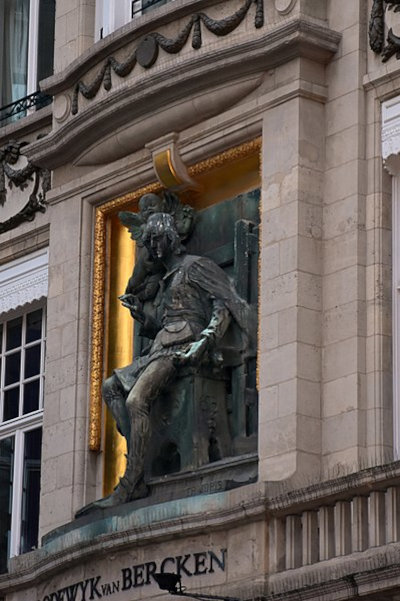 Lodewijk van Bercken monument in Antwerp
Lodewijk van Bercken monument in Antwerp
Diamonds are the toughest gemstone and are extremely difficult to cut. van Berken invented a polishing wheel coated with a diamond dust mixed with olive oil. Called a scaif, this polishing wheel completely transformed the diamond industry. Instead of rough, dull stones, diamonds suddenly became brilliantly shiny objects. Diamonds became much more popular and Antwerp’s Jewish diamond trading companies – which kept his diamond-polishing technology a tightly-held trade secret – became even more central to the growing diamond industry.
The characters in Rough Diamonds would surely know about Lodewyk van Berken: a statue of him, holding a polished diamond in his hand, stands in the heart of Antwerp’s diamond district to this day.
Diamonds were discovered in Brazil in the 1730s, adding to the world’s supply of this increasingly popular gem. However, the world’s diamond trade changed irrevocably in 1867 with a major discovery in present-day South Africa.
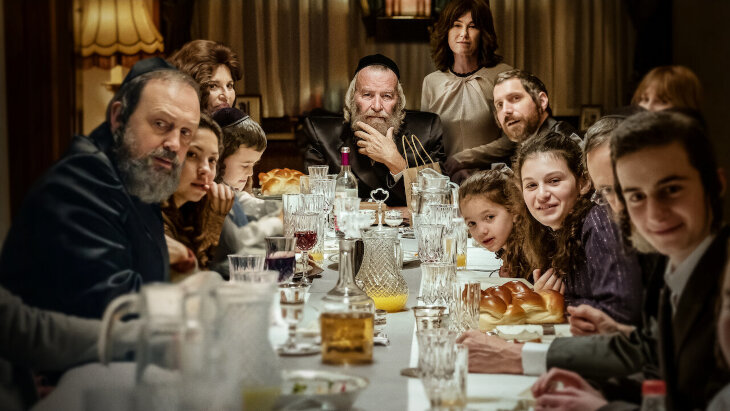 A scene from Netflix’s Rough Diamonds
A scene from Netflix’s Rough Diamonds
Dutch Boers had recently settled the Kaapvaal Craton, near the confluence of the Orange and Vaal Rivers. Displacing the native Griqua people there, the Boers began farming and noticed that their soil was studded with whitish-grey rocks. In 1867 a farmer named Schalk Niekerk picked up a pretty rock that his young son was playing with and scratched it across a window pane. It left a mark, a sure sign that the stone was a diamond.
The rock turned out to be a 21.25 carat diamond, later named the Eureka, and it helped spark a huge diamond rush in the area, near the present-day town of Kimberly.
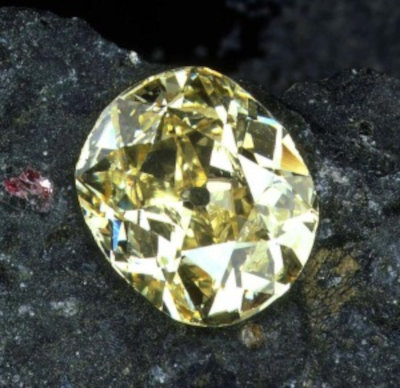 The Eureka
The Eureka
Amidst the frenzy of thousands of diamond prospectors, diamond syndicates began to form. One prominent miner was a formerly penniless Jew from the Yiddish-speaking East End of London who sailed to South Africa to try his luck. Born Barnett Isaacs, he used to perform as a juggling clown in London’s music halls, and was introduced with the tagline “And Barney too!” – he soon changed his name to Barnato, which sounded like his signature introduction.
In South Africa, Barnato began working with German Jews Alfred Beit and Ernest Oppenheimer to consolidate their mining work. In 1888, they eventually formed a partnership with Cecil John Rhodes, a wealthy Englishman who later became prime minister of the Cape Colony, called De Beers Consolidated Mines Ltd.
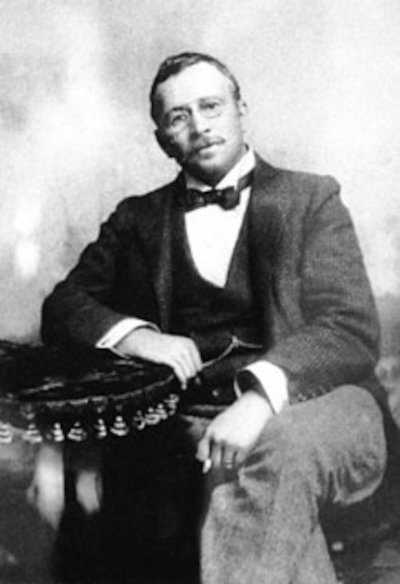 Barney Barnato
Barney Barnato
No longer owned by its founding families, De Beers remains the world’s largest diamond trading company today by far. A majority of diamonds mined today continue to come from southern Africa, including Botswana, South Africa, and Namibia. Jewish-owned firms continue to play an important role in running mining in the area and exporting stones to Europe, Israel, India, and elsewhere for polishing and re-export.
During the Renaissance, the major centers of the diamond trade coincided with the large Jewish population centers. Diamonds were sent first to London, then on Antwerp and Amsterdam for polishing. Jews controlled much of this trade. Throughout the 1800s, Antwerp steadily eclipsed Amsterdam as the hub of diamond polishing and trading, eventually becoming the world’s diamond capital. Jewish life flourished there. Netflix’s show Rough Diamonds gives a sense of Antwerp’s urbane, beautiful Hasidic world.
With the rise of Nazism in the 1930s, many of Belgium’s leading diamond traders fled, bringing their expertise and business connections with them. Cuba, New York, and the land of Israel emerged as major centers of the global diamond trade.
In May 1940, when Germany invaded Belgium, about 50,000 Jews lived in Antwerp, the diamond hub. Nazis imprisoned non-Belgian Jews who’d tried to flee to safety in Antwerp, but for months they largely left Belgian passport-holders alone in the city. Jewish diamond traders were even encouraged to continue working under Nazi control. The situation deteriorated further on April 10, 1941, when local Belgians – whipped up by Nazi propaganda – launched a vicious pogrom in Antwerp’s Jewish quarter. By 1943, the Nazis in charge of Antwerp had decided that all Jews were to be deported to death camps.
Zionist youth groups managed to smuggle some Jews to safety in Spain and Switzerland. Approximately 3,000 Jews were hidden in Antwerp during the Holocaust. 60% of Antwerp’s Jews perished. Altogether, 28,000 Belgian Jews were murdered during the Holocaust.
 Belgian Jews in the diamond district.
Belgian Jews in the diamond district.
From the ashes, Belgian’s Jews began to rebuild their shattered communities. Today, approximately 20,000 Jews call Antwerp home, many of them Hasidic. Antwerp has been called the last remaining shtetle (Yiddish-speaking town) in Europe. Rough Diamonds highlights many of the real challenges facing the Jewish community there today, including declining revenue from the diamond trade. Yet this centuries-old slice of Jewish life continues, with Jewish diamond merchants importing rough stones, then polishing diamonds in local workshops before exporting them, just as they have for generations.
Today, Indian diamond traders and polishers have largely eclipsed Jews, and India is by far the world’s largest exporter of polished diamonds. In 2021, India exported $24.7 billion worth of polished diamonds. The United States ranked second, exporting $14.8 billion worth of diamonds. Belgium exported $12.5 billion worth of polished diamonds and Israel, also a major player in the industry, exported $8.8 billion worth of polished diamonds. (The next-largest diamond exporter, Russia, exported only half as much.) .
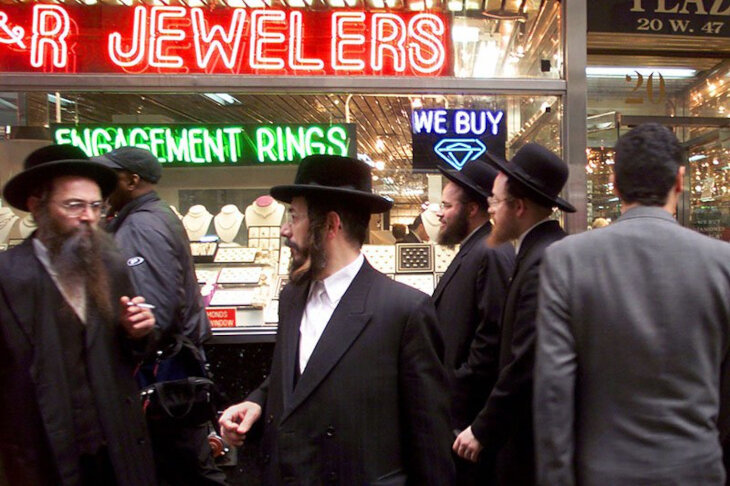 New York Diamond District
New York Diamond District
In many nations, the diamond industry remains an intensely Jewish one. A recent New York Times article describes the diamond district in New York, the destination of 90% of all diamond imports into the United States:
The jewelry district in New York emerged in the 1800s as a cluster of shops in Lower Manhattan. Later on, Jewish diamond merchants fleeing Europe before World War II began setting up on 47th Street. Much of the industry’s roots in Orthodox Jewish parts of Eastern Europe is reflected in the block’s own vocabulary, largely Yiddish. A “strop” is a second-rate stone that won’t sell; it’s “khazeray” or “shlok” – garbage….
This secret world is revealed on the upper floors above the showrooms in a honeycomb of cramped workshops, retail stalls and anonymous office suites. Here, the polishers, sorters, appraisers, graders and bench jewelers toil… High-end pieces that end up for sale at Tiffany and Harry Winston often begin their lives here as raw material…
For generations, Jewish diamond merchants and artisans have defined the industry, creating beautiful jewelry. As the industry shifts to new workers in new countries, it’s worth taking a moment to learn about the rich history of Jewish diamond workers, and to take a look at the Jewish family businesses that continue to work in the diamond trade today.
